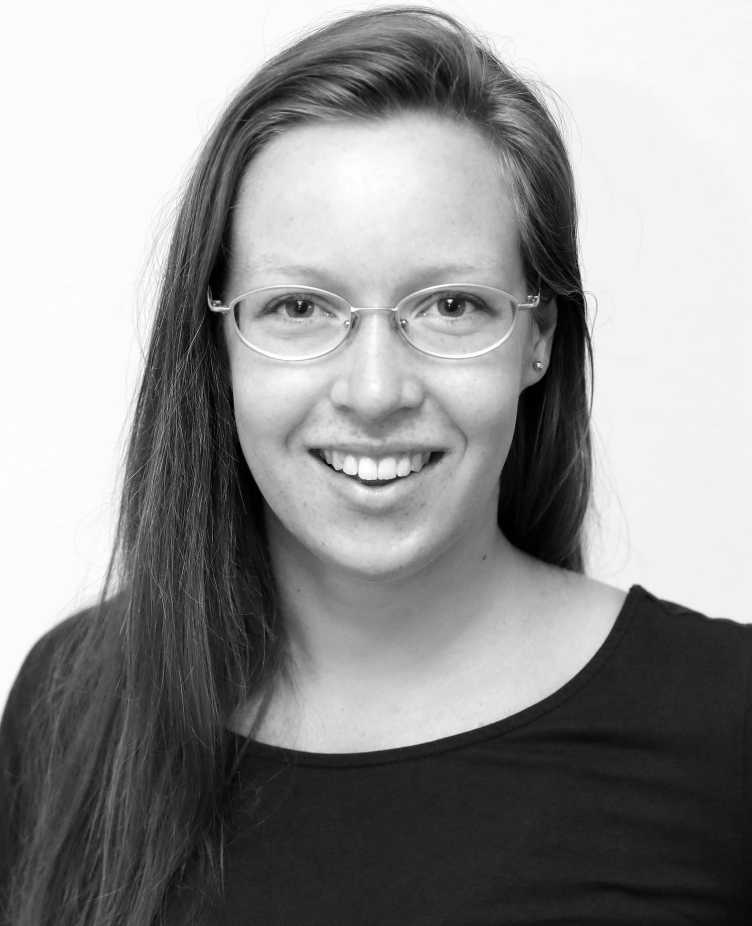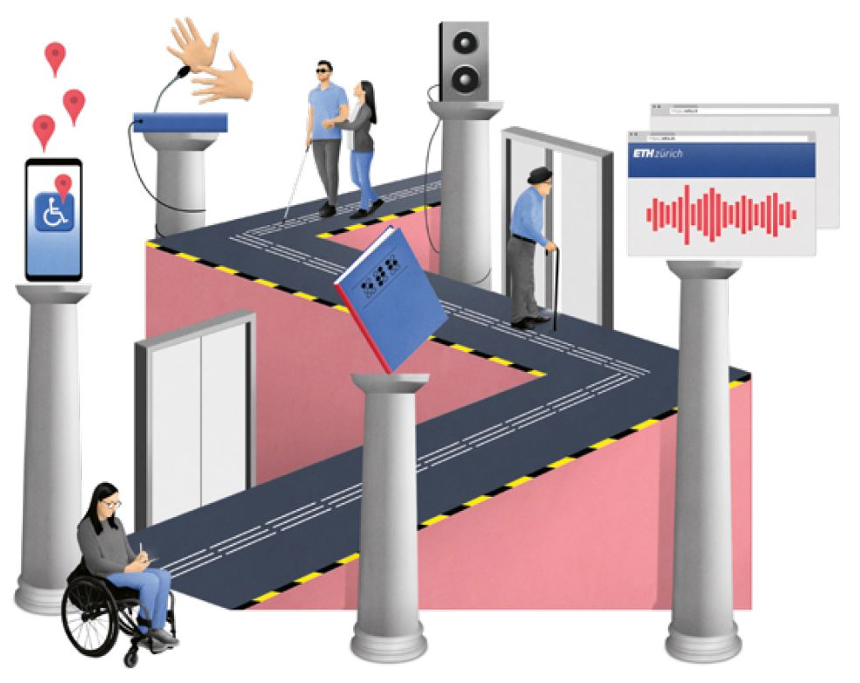“There is ‘design-for-all’ that does not cost a thing!”
The programme ‘barrier-free at ETH Zurich’ is currently being rolled out. Romila Storjohann, Manager of this Programme, explains what the programme entails, which ‘design-for-all’ elements help everyone in work and study, and why introducing a culture of inclusivity is no top-down process. An interview.

What does the term ’barrier-free’ mean in the context of a university, what does it entail…?
Thank you so much for having me and thank you for this question. I think it's an excellent question to start with. In order to explain what 'barrier-free' entails, especially in context of a university such as ETH, I brought some slides. The first illustration (Fig. 1) visualizes some, certainly not all, but some of the aspects and gives you some examples. First of all, of course barrier-free buildings, including ramps and lifts and barrier-free toilets are very important and often the first thing we think of. For example, if you have a physical impairment you may not be able to use the stairs or open the doors on your own; in that case ramps and auto-doors are extremely helpful. Another aspect of a barrier-free university are technologies that assist people with, for example, a hearing impairment or a visual impairment. This includes sub-titles to teaching videos or the production of videos in general. The use of microphones and sign language is also important at events or at lectures, or a barrier-free guidance via app. You see the example of the ETH App which might remind you of google maps. All these examples belong to the category ‘barrier-free technology’. And then there is a third part which might be a little more invisible to the eye but is nevertheless very important: and that is an unbiased, welcoming and open culture - lived and breathed, by the students, the professors, the staff, and of course the Executive Board of the University. It is hard to picture this idea of inclusion and diversity, and we tried to visualise this aspect a little better on the next image (Fig. 2). Here you see all these different figurines which represent the differences between individuals, i.e., we all face different obstacles or barriers in our lives because of our physical capabilities. For some people, these barriers are a lot higher than for others so that measures have to be taken.


The programme ’barrier-free at ETH’ was kicked off in January 2021. Where are you in the roll-out of this programme?
Yes, we are in the starting-phase (the visual I just showed is brand-new and was finished yesterday!). We were very happy that in autumn 2020, the Executive Board gave the ‘green light’ to the implementation of the programme. The aim is that over the course of the next few years people with disabilities or with special needs should benefit from improved access to ETH buildings. In early 2021 we started the ETH-wide implementation programme including 14 projects. These projects are currently being conceptualised with goals and measures, and implementation will start thereafter. This is the status quo. You may also be interested to hear about the background of this programme: The status quo was assessed as part of a smaller analysis project which was launched already in 2018 by the Vice President of Infrastructure. This resulted in a plan of action. The general idea was that this plan of action not only should fulfil the legal basis - of course there are certain laws, for example the external page Convention on the Rights of Persons with Disabilities, and then there are certain norms, which define minimal standards for buildings or the accessibility of web-content (e. g., external page SIA500). But the idea is that the plan of action should go beyond and we would like to generate 'design-for-all' guidelines for ETH.
Go ahead, it would be great to hear what is meant by ‘design-for-all’…
‘Design-for-all’ is a key principle in the categories ‘building’ and ‘technology’. One sentence that describes the principle very well is: “‘Design-for-all’ is design tailored to human diversity”. The goal here is to choose instead of stairs plus an additional stair-lift a solution everyone can use, a ramp in this example. This way everybody, not only those in a wheelchair or on crutches or with a baby-pram can enter the building easily. This classic example illustrates that we want to get away from custom-solutions towards a solution that asks the question: what will benefit everyone. Another example are auto-doors which open without touching anything which is very practical for everyone when you have your arms full with books or lunch…
..or during the pandemic when you don’t want to touch door handles….
Yes, right, this is why auto-doors are very useful for all. Another example is easy-to-use signage and guidance which is important to everyone. I can say that I still get lost in the ETH main building even after 10 years of studying and working at ETH Zurich… And, also in your new building BSS in Basel you will get this new barrier-free signage; it will be high-contrast, black and white, and the room names are touch-legible thanks to the use of relief and braille. I would also like to mention that there is ‘design-for-all’ that doesn’t cost a thing! It might seem trivial but a clear pronunciation and pauses in your speech or lecture not only help people with hearing impairment but in fact they help everyone to better concentrate and follow the content.
This is a very good point: everyone of us can really contribute to a barrier-free work and study environment by the way we speak! You currently visit different departments (or institutional units at ETH Zurich) to present the ‘barrier-free’ programme, why?
First I would like to inform the ETH community of upcoming measures. For example, it is planned for 2021/2022 to equip teaching areas with accessible desks. At some point you will also see in your seminar rooms that there are special desks marked with a special sign for people who are in a wheelchair or for people with back-pain who should stand while working. So, you will notice some changes to your environment in the near future. We will, of course, communicate throughout the whole process. Another change being planned is to become barrier-free with the many apps that exist. Also, in general, subjects need barrier-free access and inclusivity is to be integrated into the training courses for teaching. So, one reason for me presenting at all ETH units is to inform everybody about what is going on. Secondly, the idea is to establish a culture of inclusivity which will require everyone. This is not something you can do by a small group of people or steer top-down, it has to be an ETH-wide bottom-up process, it has to come from everyone of us!
Romila, thank you so much for this informative interview. It really opened my eyes, and I hope it also helped the audience to understand what ‘barrier-free’ means and how everyone of us can contribute to this endeavour.
This interview took place during the D-BSSE Digital Campus held on 27 April 2021.
Find more information on the ‘barrier-free at ETH Zurich’ website.
If you have suggestions/ideas/questions, please feel free to contact Romila via the email: hindernisfrei@ethz.ch.